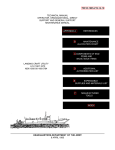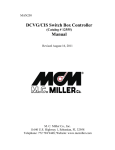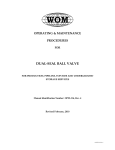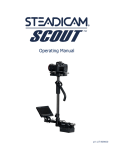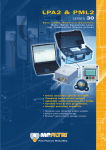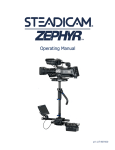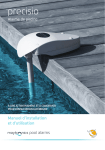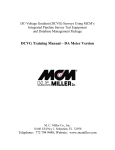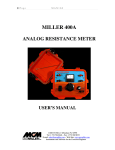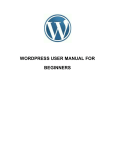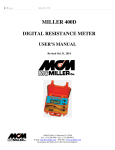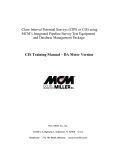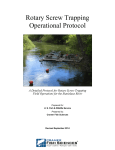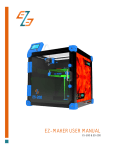Download Backpack User Guide - The M.C. Miller Company
Transcript
MCM Backpack Model BP-1 User’s Guide User’s Guide MCM Backpack Model BP-1 Part # 12715 Thank You! The M. C. Miller Co., Inc., would like to take this opportunity to thank you for the purchase of the MCM Backpack Model BP-1. We trust you will find its use in your Cathodic Protection work helpful to you and that it increases the efficiency of your efforts. This User Manual will provide you with the necessary information and instructions regarding the Backpack. Should you have any additional questions regarding the Backpack and its use, please contact MCM for assistance. There is a comment sheet in the back of this manual. After you have worked with the Backpack for a while and when you have time, please fill out the sheet, and return it to M. C. Miller Co., Inc. We are always interested in hearing from the people who work with our products everyday. M. C. Miller Co. Inc, M. C. Miller Co., Inc. 11640 US Hwy 1 Sebastian, FL 32958 772-794-9448 Fax: 772-589-9072 [email protected] www.mcmiller.com Revised: August 19, 2011 11640 US Hwy #1~ Sebastian ~ Florida ~ 32958 www.mcmiller.com ~ [email protected] Instruments and Software for the Corrosion Engineer 2 Table of Contents Subject Page Number Backpack - General Information 4 Backpack - Assembly Procedure 4 Backpack - Fitting the Backpack to the User 5 Backpack - Using the Model BP-1 Backpack 6 Installation Instruction for Gx Mounting Brackets (Optional) 7 The Data Probe – Preparation for Use 10 The Data Probe – Instructions for Use – Direct Read One Probe Only 11 The Data Probe – Instructions for Use – Direct Read Two Probes 11 The Data Probe – Instructions for Use – Continuous Read One Probe Only 12 The Data Probe – Instructions for Use – Continuous Read Two Probes 12 Continuous Read Trigger for the Gx 10 For All Data Probes 13 How to Hook up Connections for CIS Surveys 13 Automatic Triggering Option 15 Figure 1 16 Parts Lists 17 11640 US Hwy #1~ Sebastian ~ Florida ~ 32958 www.mcmiller.com ~ [email protected] Instruments and Software for the Corrosion Engineer 3 Assembling and Using the Model BP-1 Backpack General Information The Model BP-1 Backpack unit is a premium quality all-weather mountaineering pack frame to which has been added a meter table, wire spool platform (with room for a spare reel), and an optional wire-measuring device. A separate data probe with an electrode and a built-in push button switch (MCM Part# SIN015) used to manually enter a reading into a data logger such as the MCM G1 and the Gx version. The Backpack is designed for comfortable use by individuals whose height is 5‟9” (1.7 meters) or more. Customized adjustment is accomplished by straps and by coin slot adjusting screws. The Backpack meter table is designed for the Gx data logger. However, the table is large enough making it adaptable for use with other meters as needed. A meter table designed for the Allegro, SinCorder, Sin2, and G1 are available upon special order. Contact MCM at [email protected] or 772-794-9448 for more information. The Backpack is shipped in a single sturdy cardboard carton. A small amount of final assembly is needed to make the Backpack ready for use. It should take the user about fifteen minutes and requires only a medium-sized flathead and a philips screwdriver plus an ordinary pair of pliers. Assembly Procedure (See Figure 1 located on page 11 of this manual for additional assistance.) 11640 US Hwy #1~ Sebastian ~ Florida ~ 32958 www.mcmiller.com ~ [email protected] Instruments and Software for the Corrosion Engineer 4 1. Open one end of the cardboard shipping container and slide out the Backpack. 2. Remove the 11” X 13” Meter Table which is temporarily secured by bag ties to the Backpack. Install the Meter Table onto the Platform Arm Assembly. 3. Adjust the forward/backward position of the Meter Table using the Platform Locking Knob, located on the Platform Arm Assembly. The angle of the Meter Table may be adjusted using the two lock knobs, located under the Meter Table. Fitting the Backpack to the User There are several adjustments, which will tailor the Backpack to fit a particular user. The following will assist you to achieve the best fit for the user. Note: It is recommended, but not necessary to have someone assist the user in this process so as to decrease the amount of time to make the proper fitting. 1. Using a flathead screwdriver or coin, loosen both adjustable fittings on the shoulder Cross Bar (Figure 1:A). 2. Loosen the Backpack Strap (Figure 1:E) until the pads slide up and down on the frame. 3. Hoist the Backpack to your back by grabbing the top bar from underneath with one hand. Note: You may wish to first hoist the Backpack to the top of your right thigh, resting it there … just above the knee. Grab the pack with your left hand and slide your right arm through the shoulder strap. Hoist the Backpack onto your back. Insert your left arm through the left shoulder strap. 4. Adjust the Padded Waist Belt (Figure 1:N) and Shoulder Straps (Figure 1:D) making sure that the Backpack is snug and secure. Note: The position of the shoulder level crossbar should be directly opposite or slightly above the cervical bone located at the base of the user‟s neck. If this is not the case, move the adjustable fittings up or down by following “a” or “b” below or both. Once in the correct position, tighten the fittings. a. Padded Waist Belt: Position the Padded Waist Belt by adjusting the two vertical gray straps causing the band to move either up or down. Adjust as needed to fit the user. The padded waist belt should be fitted directly around the user‟s waist. This provides the greatest degree of comfort while walking. b. Upper Padded Back Band: Position the Upper Padded Back Band by adjusting the two horizontal gray straps causing the band to move either up or down. Adjust as needed to fit the user. 5. Adjust the width of the shoulder straps for the greatest comfort. Move the 11640 US Hwy #1~ Sebastian ~ Florida ~ 32958 www.mcmiller.com ~ [email protected] Instruments and Software for the Corrosion Engineer 5 pad to the outside set of holes if the pads touch the user‟s neck. Do Not over tighten the nuts and bolts; one thread showing past the nylon insert locks them. Leave enough play for the pads to swivel slightly. 6. Using the waist suspension system allows the user to transfer the weight from their shoulders and back to their waist. The Backpack is adjustable from the bottom up, providing maximum variability. It also increases the ability to transfer and adjust the load, helping to prevent unnecessary back and shoulder fatigue. Using the Model BP-1 Backpack The Backpack is especially useful for Close Interval Surveys (CIS) because the adjustable Meter Table may be adapted by the user to accept a variety of data loggers, indicating meters, or even a strip-chart recorder. The following suggested procedures assume that the user has the optional footage counter and data probe accessories. Should the user not have either or both accessories, the user may skip the steps that refer to them. 1. Adjust the Backpack to fit the user wearing it. 2. Remove the Terminal Post Assembly (Figure 1:F). To do this, unscrew the white plastic base from the Spool Post. 3. Slide a spool of #30 wire onto the Spool Post (Figure 1:G). Make sure the pigtail wire from the Hub is on the upper side. Replace the Terminal Post Assembly. 4. Using a pocketknife or sandpaper, remove the enamel insulation from at least 1” of both the inner and outer ends of the #30 wire. Extra Caution should be used in order to not break the pigtail lead. 5. Insert the inner end of the wire into the BLACK (negative) terminal post located on the top of the Spool Post. Turn the Terminal Nut (Figure 1:B) until it “snugs up” onto the wire. Do Not over tighten, as damage to the inner wire will occur. 6. Unscrew the Captive Wire-threading Needle (Figure 1:C) from the right side of the wire measure. Push it straight down … through the fairleader spring (Figure 1:H) on the top of the Wire Measurer. Thread the outer end of the #30 wire through the eye of needle. Pull the needle back up out of the Wire Measurer. This insures that the wire is properly situated within the Wire Measurer. 7. Mount the Gx meter to the Meter Table supplied with the Backpack. The Meter Table includes the Digital Counter (MCM Part# SUB420). a. The Meter Table should be removed from the bar it is attached to by releasing the bar from the Meter Table via the two black knobs. Removing the Meter Table is not required, but you will find it easier to mount the Gx if you do. 11640 US Hwy #1~ Sebastian ~ Florida ~ 32958 www.mcmiller.com ~ [email protected] Instruments and Software for the Corrosion Engineer 6 Installation Instructions for Gx Mounting Brackets (Gx Bracket Kit: Catalog # 11273 – To integrate a Gx Data-logger with a Gx Platform) The mounting brackets (Top Bracket and Bottom Bracket) are supplied with their hardware (screws & spacers) pre-installed, as shown opposite. Step 1: Place the Gx data-logger front-side down on a clean, flat surface and remove the four screws highlighted in the photograph shown opposite using a flat-head screwdriver. Next, remove the hand strap and associated brackets from the unit. This will reveal 4 tapped holes (two on the top and two on the bottom). 11640 US Hwy #1~ Sebastian ~ Florida ~ 32958 www.mcmiller.com ~ [email protected] Instruments and Software for the Corrosion Engineer 7 Step 2: Line up the Top Bracket screws with the top two tapped holes, as shown in the photograph opposite, and secure the Top Bracket using a Phillips-head screwdriver. Note: Do not over-tighten the screws so as not to strip the threads. Step 3: Line up the Bottom Bracket with the bottom two tapped holes, as shown in the photograph opposite, and secure the Bottom Bracket using a Phillips-head screwdriver. Note: Do not over-tighten the screws so as not to strip the threads. Also, make sure that the flat washers are in place. Step 4: If required, adjust the position of each ball bearing on the Bottom Bracket, using a flat-head screwdriver as indicated in the photograph opposite, for a best fit with the corresponding bracket on the Gx Platform. 11640 US Hwy #1~ Sebastian ~ Florida ~ 32958 www.mcmiller.com ~ [email protected] Instruments and Software for the Corrosion Engineer 8 The Gx has two brackets top and bottom. b. The Back-Pack meter table also has to matting Bracket on it. Both will match to clip on for easy on and easy removal. There are adjustment screws you can adjust to make the brackets fit tighter or looser to your comfort. c. Reattach the Gx to the Platform. d. Reattach the Meter Table to the aluminum bar. 8. Attach the appropriate Data Probe and related wiring as described in the section of this manual titled The Data Probe. Go to this section now and then return here once the Data Probe(s) is attached. 9. A spare spool of #30 wire may be mounted on the lower end of the Spool Post should you anticipate using all the wire on the main spool during the testing period. 10. Pull several feet of the wire up through the Wire Measurer, insuring that the wire is feeding easily. Reset the Counter back to 0 (zero) or a black screen by pushing the RED button. 11. Attach the bare end of the wire to the terminal of the test station or test point. Make sure there will be no strain on the connection. 12. Make descriptive entries into the meter in order to later identify the survey. These entries should provide the answers to the questions of „who,‟ „what,‟ „when,‟ and „where.‟ 13. After making sure that all the meter switches are in the correct position, begin the survey. Take readings at regular intervals as indicated by the Wire Measurer‟s display. 14. MCM suggests that the used wire be removed from the test site daily. This avoids any potential nuisance to property owners and animals. WARNING: The Wire Measurer is calibrated for use ONLY with special #30 and #34 wire. The use of any other size or type of wire will seriously affect the accuracy of the Wire Measurer. The #30 wire recommended for use with the Model BP-1 Backpack is available from M. C. Miller Co., Inc. on spools of a single and continuous length of approximately five miles. #34 wire is available in 1 mile and 3 mile spools. The wire Should Be removed from the Wire Measurer at the end of the survey in order to prevent the neoprene measuring wheel from taking a “set” which will cause the slippage of wire when the Wire Measurer is used next. 11640 US Hwy #1~ Sebastian ~ Florida ~ 32958 www.mcmiller.com ~ [email protected] Instruments and Software for the Corrosion Engineer 9 The Data Probe Preparation for Use Data Probes do not come with the Backpack. If a data probe is ordered and used with the Backpack, the following information will explain the proper setup and use of the probe. Note: There are different data probes available for use. The following instructions will include the variables in the set up for each type. Be sure you know the type of probe you are using and whether you will be taking positive or negative survey readings. As received, the electrode on the Data Probe will contain no liquid. There is, however, a quantity of blue-copper sulfate crystals in the orange plastic tube. 1. To prepare the electrode for use (*SEE WARNING on Page 11), unscrew the porous plug assembly from the bottom of the tube and fill the tube with distilled water or MCM’s Electrode Anti-Freeze Solution (MCM Part# 17105 or 17207). 2. Replace the porous plug assembly and tighten firmly so as to effectively seal the tube. Try to avoid getting crystals on the threaded portion of the tube. 3. Shake the tube a few times to insure a saturated solution is created as soon as possible. The solution will be blue in color and there should always be some undissolved copper-sulfate crystals at the bottom of the tube. 4. After filling, allow at least five minutes for the porous plug to wet up before using the probe. It is normal for the porous plug to leak slightly until the pressure within the tube equalizes with atmospheric pressure. 5. MCM recommends that the protective cap be left off the electrode for the first two hours after the water has been added. The initial leakage, which may occur, is corrosive to many metals and should not be allowed to seep into any test equipment. When the leakage stops, the protective cap should be kept on the plug whenever the probe is not actually in use. 11640 US Hwy #1~ Sebastian ~ Florida ~ 32958 www.mcmiller.com ~ [email protected] Instruments and Software for the Corrosion Engineer 10 Instructions for Use Using the Gx Data Probe (MCM Part# SIN015) Direct Read to the Gx – One Probe Only 1. Choose the Positive or Negative Coiled Data Probe Cable (depending on whether you will be taking Positive or Negative readings). 2. Take the Male end of the cable and attach it to the Gx port. The cable will fit only one port of the Gx and it is keyed to that port. Do Not force the cable to attach. 3. Mount the Meter Table to the Backpack (assuming it is not already attached) by sliding to aluminum pole attached to the Meter Table into the appropriate slot on the lower right side of the Backpack. Secure it by tightening the black knob. 4. Take the Black coiled cord from the Backpack and attach the end to the Counter attached to the Meter Table. You will find it helpful to wrap the cord around the metal pole of the table to help keep the cord from catching onto brush etc. as you take the survey. 5. Depending on which Coiled Data Probe Cable you use (Positive or Negative), take the Positive (Red) or Negative (Black) straight cord with the stacked banana plugs (supplied with the Backpack) and attach one end to the Digital Counter and the other end to the banana jack of the Gx (Red for Positive or Black for Negative). 6. Attach the female end of the Coiled Data Probe Cord to the Data Probe. Using the Gx Data Probe (MCM Part# SIN015) Direct Read to the Gx – Two Probes 1. Locate the Dual Data Probe Adapter (MCM Part# SIN017), located on the underside of the Meter Table. 2. Attach the male end of cord running from the Dual Data Probe Adapter to the Gx port. The cable will fit only one port of the Gx and it is keyed to that port. Do Not force the cable to attach. 3. Attach both coiled Data Probe cables (Positive or Negative) to the Dual Data Probe Adapter (one cables to each connection). 4. Mount the Meter Table to the Backpack (assuming it is not already attached) by sliding to aluminum pole attached to the Meter Table into the appropriate slot on the lower right side of the Backpack. Secure it by tightening the black knob. 5. Take the Black coiled cord from the Backpack and attach the end to the Digital Counter attached to the Meter Table. You will find it helpful to wrap the cord around the metal pole of the table to help keep the cord from catching onto brush etc. as you take the survey. 6. Depending on which Coiled Data Probe Cable you use (Positive or Negative) take the Positive (Red) or Negative (Black) straight cord with the 11640 US Hwy #1~ Sebastian ~ Florida ~ 32958 www.mcmiller.com ~ [email protected] Instruments and Software for the Corrosion Engineer 11 stacked banana plugs (supplied with the Backpack) and attach one end to the Counter and the other end to the banana jack of the Gx (Red for Positive or Black for Negative). 7. Attach the female end of each coiled Data Probe Cord to the Data Probe. Using the Data Probe (MCM Part# TRI014) Continuous Read with the Gx - One Probe Only 1. The Gx should already be attached to the Meter Table. The Backpack should be already attached to the Meter Table and Counter. 2. Using the Continuous Read Data Probe, insert the cord from the probe into the appropriate banana plug receptacle of the Gx (Negative if taking negative reads or Positive for taking positive reads). 3. Depending on which type of reading you will be taking (Positive or Negative), take the Positive (Red) or Negative (Black) straight cord with the stacked banana plugs (supplied with the Backpack) and attach one end to the Counter and the other end to the open banana jack of the Gx. Using the Data Probe (MCM Part# TRI014) Continuous Read with the Gx - Two Probes 1. The Gx should already be attached to the Meter Table. The Backpack should be already attached to the Meter Table and Counter. 2. Using the Continuous Read Data Probes, insert the cord from the first probe into the appropriate banana plug receptacle of the Gx (Negative if taking negative reads or Positive for taking positive reads). 3. Using the second probe, insert its cord into the top of the stackable banana jack of the first data probe. Depending on which type of reading you will be taking (Positive or Negative), take the Positive (Red) or Negative (Black) straight cord with the stacked banana plugs (supplied with the Backpack) and attach one end to the Counter and the other end to the open banana jack of the Gx. Continuous Read Trigger for the Gx The Backpack and its Counter will allow automatic triggering of reads as the user walks along the route of the survey. As the user travels every 2.5 feet, the Counter triggers (an audible beep is heard) and a reading is transmitted from the data probe to the Gx at that moment. 11640 US Hwy #1~ Sebastian ~ Florida ~ 32958 www.mcmiller.com ~ [email protected] Instruments and Software for the Corrosion Engineer 12 This is accomplished by attaching the Trigger Cable (MCM# SIN024) from the Counter to the Gx. 1. Take the Trigger Cable and screw one end into the appropriate terminal of the Gx. The coupling allows the cable to only attach one way. Do not force the cable onto the Gx. 2. Attach the other end of the Trigger Cable to the positive and negative terminals located on the underside of the Meter Table. The terminals are two #Phillips head screws (one marked (+) and the other marked (-). The Trigger Cable end has two terminals, RED for positive and BLACK for negative. Note: care should be taken to insert each terminal end between the screw head and the washer. This assures and strong contact. For All Data Probes 1. Remove the ORANGE protective cap from the porous plug. 2. Insert the Data Probe‟s DIN connector carefully into the “Trigger” Port. This port is located on the same side as the input terminals. The DIN and the BLACK release button on it should face up. Properly inserted, the DIN connector will snap into place and lock. To remove, press the BLACK button and pull out gently. 3. Place the porous plug into contact with the earth. Press the RED button on the Data Probe handle. This causes the Gx to take readings. (This assumes that the Gx is in one of its trigger modes and has been activated (indicated by a blinking “L” in the upper left hand corner of the display). Refer to the Gx manual for additional information. * WARNING: DO NOT unscrew the WHITE plastic cap and copper-rod assembly from the aluminum tube. Doing so will cause internal wiring to twist and break. How to Hook Up Data-Probe Cables and make final Backpack Connections for CIS Surveys 1. Turn the data-probe platform upside down and connect the two MCM black-band cables (assuming that you will be measuring normally negative pipe-to-soil readings) to the dual-probe adapter unit mounted on the underside of the data-logger platform. 2. Assuming that your data-logger is mounted on the top side of the datalogger platform and that the output cable of the dual-probe adapter has been connected to the 5-pin terminal on the data-logger, mount the datalogger platform to the Backpack, by sliding the platform arm assembly into the appropriate slot on the lower right side of the Backpack. Secure it by tightening the black knob. 3. Connect the black coiled cable from the Backpack to the counter/display 11640 US Hwy #1~ Sebastian ~ Florida ~ 32958 www.mcmiller.com ~ [email protected] Instruments and Software for the Corrosion Engineer 13 unit mounted on the data-logger platform. You will find it helpful to wrap the cord around the metal pole to help keep the cord from catching onto brush etc. as you perform the survey. 4. Connect the short (red) banana plug cable between the counter/display unit and the red banana plug terminal on the data-logger (again, assuming normally negative pipe-to-soil readings will be recorded). 5. Finally, connect the other ends of the data-probe cables to the redhandled and the green handled data-probes. These MCM data-probes have push-button switches that allow the user to manually-trigger readings. The configuration described above is illustrated in Figure 2 below. This configuration is used for the case of manually-triggered readings (see your datalogger‟s User‟s Manual or the CIS Training Manual for details) using the pushbutton switches on the data-probes. Figure 2 11640 US Hwy #1~ Sebastian ~ Florida ~ 32958 www.mcmiller.com ~ [email protected] Instruments and Software for the Corrosion Engineer 14 Automatic Triggering Option The Backpack is supplied with an automatic trigger cable that can be used to trigger readings automatically each time 2.5 feet (or 1 meter in the metric option case) of trail wire is fed through the wire measurer. For this option, which is illustrated in Figure 3 below, the trigger cable is connected to the 5-pin terminal on the data-logger and the MCM data-probe cables are not used. Note: The banana plug cables shown in Figure 3 (to the data-probes) are supplied by the customer. Figure 3 11640 US Hwy #1~ Sebastian ~ Florida ~ 32958 www.mcmiller.com ~ [email protected] Instruments and Software for the Corrosion Engineer 15 Figure 1 Parts Lists The following are key parts to the Backpack and may be used as a guide for ordering replacement parts as needed. 11640 US Hwy #1~ Sebastian ~ Florida ~ 32958 www.mcmiller.com ~ [email protected] Instruments and Software for the Corrosion Engineer 16 Backpack Table with Cables – Part # SIN065 (Combined Unit as Shown Below) A B C D E F G 2 2 2 1 2 1 1 1 Part # HAR295 Part # HAR330 Part # HAR303 Part # SIN017 Part # KNO015 Part # PAN075/A Part # SUB420 Part # SIN026 1 Part # SIN024 #10 x1/2” Long Nylon Spacer 10-32 x 1 ¾” Philips FL Head 10-32 Nylon Lock Screw Sin2 Dual Data Probe Adapter Knob Table BP-1 Backpack Front Panel Audible Display (USA) Backpack Red and Black Test Lead (Not Shown) Trigger Cable (Not Shown) 11640 US Hwy #1~ Sebastian ~ Florida ~ 32958 www.mcmiller.com ~ [email protected] Instruments and Software for the Corrosion Engineer 17 Backpack Spool Table – Part # SIN067 (Combined Unit as Shown Below) A B C D E F 1 1 1 1 1 1 Part # HIP030 Part # SUB440 Part # WIR047 Part # PAN075 Part # WIR057 Part # SUB450 Spool Lock with Terminal Spool Post Assembly 6” Diameter Rubber Pad Backpack Spool Table Quick Release Pin Spool Post Frame Assembly 11640 US Hwy #1~ Sebastian ~ Florida ~ 32958 www.mcmiller.com ~ [email protected] Instruments and Software for the Corrosion Engineer 18


















